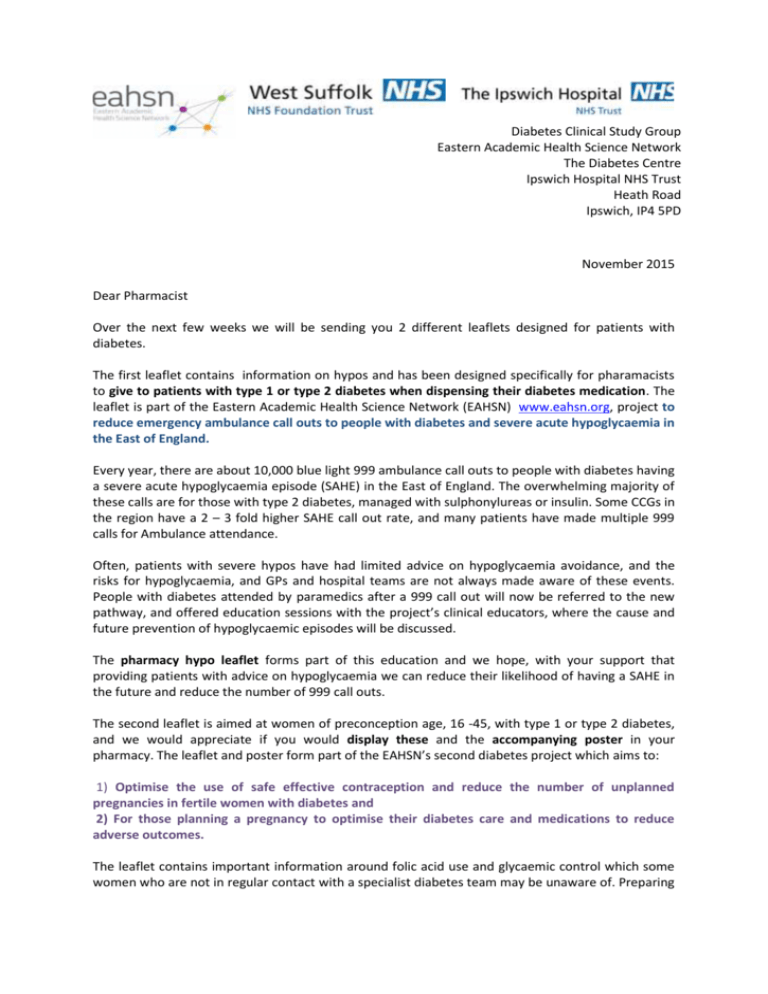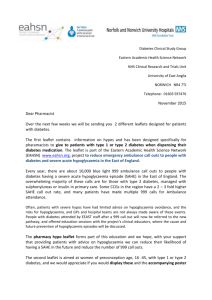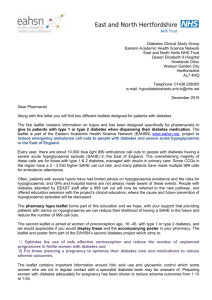Pharmacist letter final
advertisement

Diabetes Clinical Study Group Eastern Academic Health Science Network The Diabetes Centre Ipswich Hospital NHS Trust Heath Road Ipswich, IP4 5PD November 2015 November 2015 Dear Pharmacist Over the next few weeks we will be sending you 2 different leaflets designed for patients with diabetes. The first leaflet contains information on hypos and has been designed specifically for pharamacists to give to patients with type 1 or type 2 diabetes when dispensing their diabetes medication. The leaflet is part of the Eastern Academic Health Science Network (EAHSN) www.eahsn.org, project to reduce emergency ambulance call outs to people with diabetes and severe acute hypoglycaemia in the East of England. Every year, there are about 10,000 blue light 999 ambulance call outs to people with diabetes having a severe acute hypoglycaemia episode (SAHE) in the East of England. The overwhelming majority of these calls are for those with type 2 diabetes, managed with sulphonylureas or insulin. Some CCGs in the region have a 2 – 3 fold higher SAHE call out rate, and many patients have made multiple 999 calls for Ambulance attendance. Often, patients with severe hypos have had limited advice on hypoglycaemia avoidance, and the risks for hypoglycaemia, and GPs and hospital teams are not always made aware of these events. People with diabetes attended by paramedics after a 999 call out will now be referred to the new pathway, and offered education sessions with the project’s clinical educators, where the cause and future prevention of hypoglycaemic episodes will be discussed. The pharmacy hypo leaflet forms part of this education and we hope, with your support that providing patients with advice on hypoglycaemia we can reduce their likelihood of having a SAHE in the future and reduce the number of 999 call outs. The second leaflet is aimed at women of preconception age, 16 -45, with type 1 or type 2 diabetes, and we would appreciate if you would display these and the accompanying poster in your pharmacy. The leaflet and poster form part of the EAHSN’s second diabetes project which aims to: 1) Optimise the use of safe effective contraception and reduce the number of unplanned pregnancies in fertile women with diabetes and 2) For those planning a pregnancy to optimise their diabetes care and medications to reduce adverse outcomes. The leaflet contains important information around folic acid use and glycaemic control which some women who are not in regular contact with a specialist diabetes team may be unaware of. Preparing women with diabetes adequately for pregnancy has been shown to reduce adverse outcomes from 1:10 to 1:55. For more information on either project please visit www.eahsn.org or contact us on the details below. We thank you for your support with these important initiatives Yours sincerely Dr Gerry Rayman Diabetes Consultant Ipswich Hospital Dr John Clark Diabetes Consultant West Suffolk Hospital Amanda Harries, Programme Manager Diabetes Clinical Study Group, Eastern Academic Health Science Network/ Sadie Cooper, Clinical Educator East Suffolk/Lisa Newdick, Clinical Educator West Suffolk /Emma Page, Project Manager East Suffolk/Lynn Dorsett Project Manager West Suffolk







